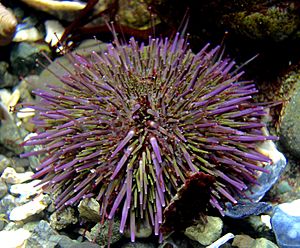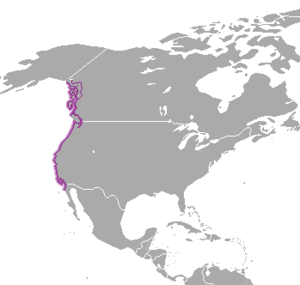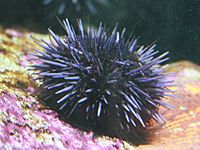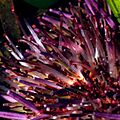Purple sea urchin facts for kids
Quick facts for kids Purple sea urchin |
|
|---|---|
 |
|
| Scientific classification | |
| Kingdom: | |
| Phylum: | |
| Class: | |
| Subclass: |
Euechinoidea
|
| Superorder: |
Echinacea (animal)
|
| Order: |
Echinoida
|
| Family: |
Strongylocentrotidae
|
| Genus: |
Strongylocentrotus
|
| Species: |
S. purpuratus
|
| Binomial name | |
| Strongylocentrotus purpuratus (Stimpson, 1857)
|
|
 |
|
The purple sea urchin, also known as Strongylocentrotus purpuratus, is a fascinating sea creature. It lives along the eastern side of the Pacific Ocean. You can find it from Ensenada, Mexico, all the way up to British Columbia, Canada.
This type of sea urchin is a deep purple color. It lives in rocky areas near the shore, both in shallow waters that are sometimes exposed at low tide and in slightly deeper waters. Its eggs are bright orange when released into the water.
Purple sea urchins usually grow to be about 10 centimeters (4 inches) wide. They can live for a very long time, sometimes up to 70 years!
Contents
Life Cycle and Reproduction
Purple sea urchins typically reproduce during January, February, and March. This is when they are most active in creating new life. They become old enough to reproduce when they are about two years old.
Why Scientists Study Purple Sea Urchins
Scientists often study the purple sea urchin for many reasons. They are especially interested in how these creatures develop from an embryo. They also want to understand the urchin's amazing ability to regrow damaged body parts.
Scientists have found that purple sea urchins share many genes with humans. This means studying them can give us clues about human health and diseases. For example, researchers have looked at the urchin's genes to learn more about conditions like Alzheimer's disease and cancer. They found a special part of the urchin's genes that might help cells return to a younger state. This could lead to better ways to treat diseases.
The purple sea urchin is also studied because it lives for so long. Scientists compare younger and older urchins to see how they stay healthy. They found that even older urchins can still regrow and repair their tissues very well. This shows their amazing ability to regenerate, or fix themselves.
The Purple Sea Urchin's Genetic Code
In 2006, scientists fully mapped out the purple sea urchin's genome. A genome is like a complete instruction book for how an organism is built and how it works. This was a big step because the sea urchin was the first animal of its kind to have its full genetic code known.
The sea urchin's genome is special for several reasons:
- It's a free-living animal that moves around in the ocean.
- Its babies start out with two symmetrical sides, but the adults have a round, star-like shape.
- It has a unique internal skeleton and a water vascular system, which are features only found in echinoderms (the group sea urchins belong to).
- It has a very complex immune system that helps it fight off sickness.
Scientists found that the purple sea urchin has about 23,500 genes. Many of these genes are similar to ones found in humans and other animals with backbones. This helps scientists understand how different animals are related and how genes have changed over time. For example, the sea urchin has many genes that help it sense its environment, even though it doesn't have a head like we do.
The sea urchin also has a special defense system. It helps the urchin react to stress and get rid of harmful chemicals. Its immune system has special receptors that can spot germs.
Scientists have also learned that changes in the ocean, like more carbon dioxide, can affect the purple sea urchin. Higher carbon dioxide levels can change how its genes work and can even make its larvae (baby urchins) smaller. This could make it harder for them to survive.
Life in the Ocean and Human Uses
The purple sea urchin is an important part of the kelp forest community. It lives alongside animals like sea otters and abalones. Sea urchins eat kelp, and sea otters eat sea urchins, helping to keep the kelp forests healthy.
Native peoples of California have traditionally eaten the yellow egg mass of the purple sea urchin. They would eat it raw. Today, the purple sea urchin is still harvested for food. The best time to harvest them for eating is usually in September and October, when their edible parts are largest.
Sometimes, if there are too many sea urchins, they can eat too much kelp. This can cause kelp forests to disappear, especially with changes happening due to climate change.
Images for kids
-
Close up of Strongylocentrotus purpuratus clearly showing tube feet.




